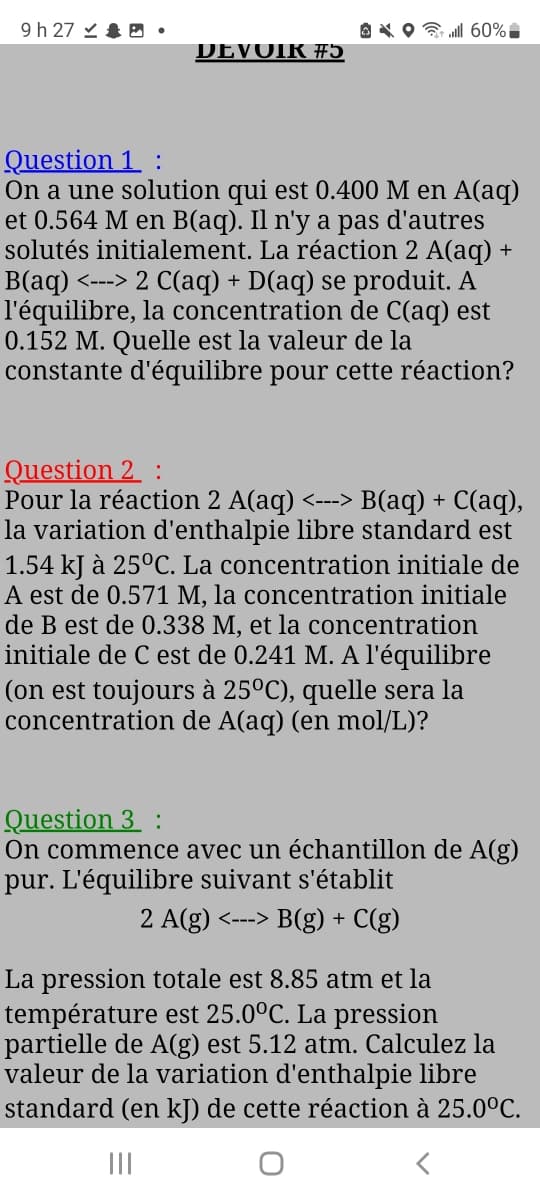On a une solution qui est 0.400 M en A(aq) et 0.564 M en B(aq). Il n'y a pas d'autres solutés initialement. La réaction 2 A(aq) + B(aq) <---> 2 C(aq) + D(aq) se produit. A l'équilibre, la concentration de C(aq) est 0.152 M. Quelle est la valeur de la constante d'équilibre pour cette réaction?
On a une solution qui est 0.400 M en A(aq) et 0.564 M en B(aq). Il n'y a pas d'autres solutés initialement. La réaction 2 A(aq) + B(aq) <---> 2 C(aq) + D(aq) se produit. A l'équilibre, la concentration de C(aq) est 0.152 M. Quelle est la valeur de la constante d'équilibre pour cette réaction?
Chemistry
10th Edition
ISBN:9781305957404
Author:Steven S. Zumdahl, Susan A. Zumdahl, Donald J. DeCoste
Publisher:Steven S. Zumdahl, Susan A. Zumdahl, Donald J. DeCoste
Chapter18: Electrochemistry
Section: Chapter Questions
Problem 9RQ: What characterizes an electrolytic cell? What is an ampere? When the current applied to an...
Related questions
Question
100%

Transcribed Image Text:9 h 27.
DEVOIR #5
OXO
60%-
Question 1 :
On a une solution qui est 0.400 M en A(aq)
et 0.564 M en B(aq). Il n'y a pas d'autres
solutés initialement. La réaction 2 A(aq) +
B(aq) <---> 2 C(aq) + D(aq) se produit. A
l'équilibre, la concentration de C(aq) est
0.152 M. Quelle est la valeur de la
constante d'équilibre pour cette réaction?
Question 2 :
Pour la réaction 2 A(aq) <---> B(aq) + C(aq),
la variation d'enthalpie libre standard est
1.54 kJ à 25°C. La concentration initiale de
A est de 0.571 M, la concentration initiale
de B est de 0.338 M, et la concentration
initiale de C est de 0.241 M. A l'équilibre
(on est toujours à 25ºC), quelle sera la
concentration de A(aq) (en mol/L)?
Question 3 :
On commence avec un échantillon de A(g)
pur. L'équilibre suivant s'établit
2 A(g) <---> B(g) + C(g)
La pression totale est 8.85 atm et la
température est 25.0°C. La pression
partielle de A(g) est 5.12 atm. Calculez la
valeur de la variation d'enthalpie libre
standard (en kJ) de cette réaction à 25.0°C.
|||
Expert Solution
This question has been solved!
Explore an expertly crafted, step-by-step solution for a thorough understanding of key concepts.
Step by step
Solved in 2 steps with 2 images

Knowledge Booster
Learn more about
Need a deep-dive on the concept behind this application? Look no further. Learn more about this topic, chemistry and related others by exploring similar questions and additional content below.Recommended textbooks for you

Chemistry
Chemistry
ISBN:
9781305957404
Author:
Steven S. Zumdahl, Susan A. Zumdahl, Donald J. DeCoste
Publisher:
Cengage Learning

Chemistry: An Atoms First Approach
Chemistry
ISBN:
9781305079243
Author:
Steven S. Zumdahl, Susan A. Zumdahl
Publisher:
Cengage Learning


Chemistry
Chemistry
ISBN:
9781305957404
Author:
Steven S. Zumdahl, Susan A. Zumdahl, Donald J. DeCoste
Publisher:
Cengage Learning

Chemistry: An Atoms First Approach
Chemistry
ISBN:
9781305079243
Author:
Steven S. Zumdahl, Susan A. Zumdahl
Publisher:
Cengage Learning


Chemistry: The Molecular Science
Chemistry
ISBN:
9781285199047
Author:
John W. Moore, Conrad L. Stanitski
Publisher:
Cengage Learning

Chemistry: Principles and Practice
Chemistry
ISBN:
9780534420123
Author:
Daniel L. Reger, Scott R. Goode, David W. Ball, Edward Mercer
Publisher:
Cengage Learning

Principles of Modern Chemistry
Chemistry
ISBN:
9781305079113
Author:
David W. Oxtoby, H. Pat Gillis, Laurie J. Butler
Publisher:
Cengage Learning